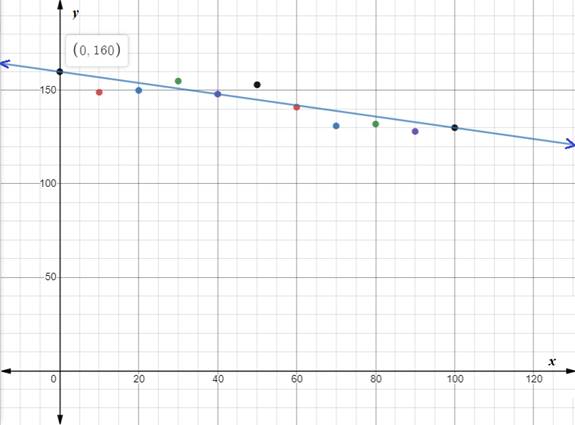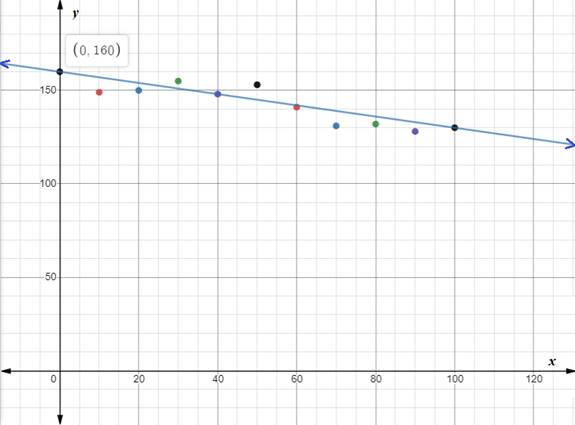
Concept explainers
a.
To make:
A
a.
Answer to Problem 33E
The line of best fit would look like:

Explanation of Solution
Given:
The table below shows the men’s winning timesin the Boston Marathon for every tenth year from 1900 to 2000. In the table, x represents the number of years since 1900, and y represents the corresponding winning time (to the nearest minute).

Calculation:
First of all, we will write our given data as ordered pairs
Now we will plotour given values on coordinate plane and draw a line of best fit as shown below:

b.
To write:
An equation for the line of best fit.
b.
Answer to Problem 33E
The equation for the line of the best fit would be
Explanation of Solution
Given:
The table below shows the men’s winning times in the Boston Marathon for every tenth year from 1900 to 2000. In the table, x represents the number of years since 1900, and y represents the corresponding winning time (to the nearest minute).

Calculation:
First of all, we will find slope of line passing through point (0,160) and (100,130) as:
Now we will use slope-intercept form to write our equation as:
Therefore, the equation for the line of the best fit would be
c.
To predict:
The men’s winning time in the Boston Marathon for the year 2010.
c.
Answer to Problem 33E
Men’s winning time in the Boston Marathon for the year 2010would be 127 minutes.
Explanation of Solution
Given:
The table below shows the men’s winning times in the Boston Marathon for every tenth year from 1900 to 2000. In the table, x represents the number of years since 1900, and y represents the corresponding winning time (to the nearest minute).

Calculation:
To predict men’s winning time in the Boston Marathon for the year 2010, we will substitute
Therefore, men’s winning time in the Boston Marathon for the year 2010 would be 127 minutes.
d.
Do you think your equation will accurately predict winning times far into the future? Explain your reasoning.
d.
Answer to Problem 33E
The equation will not accurately predict winning times far into the future.
Explanation of Solution
Given:
The table below shows the men’s winning times in the Boston Marathon for every tenth year from 1900 to 2000. In the table, x represents the number of years since 1900, and y represents the corresponding winning time (to the nearest minute).

Calculation:
The line of best fit is for our given data. The slope of the line is negative, so as the x values will increase the value of y will approach zero. Our equation for the line of best fit can predict winning times close to year 2000.
Since we cannot expect all data points to fall on the line of best fit, therefore, the equation will not accurately predict winning times far into the future.
Chapter 8 Solutions
EBK PRE-ALGEBRA
Additional Math Textbook Solutions
Introductory Statistics
College Algebra (7th Edition)
Precalculus
Basic Business Statistics, Student Value Edition
Calculus: Early Transcendentals (2nd Edition)
A Problem Solving Approach To Mathematics For Elementary School Teachers (13th Edition)
- ) Graph the feasible region subject to the following constraints. x + y ≤ 6 y ≤ 2x x ≥ 0, y ≥ 0 P + xarrow_forwardSolve the following system of equations: 50x+20y=1800 10x+3y=300arrow_forward> > > we are hiring Salesforce Admin Location: Remote Key Responsibilities: Administer Salesforce Sales & Revenue Cloud (CPQ & Billing) Configure workflows, validation rules & dashboards Automate processes using Flows & Process Builder Collaborate with Sales, Finance & Marketing teams Manage user roles & security Apply: Hr@forcecraver.comarrow_forward
- Answer this questionarrow_forward1. vector projection. Assume, ER1001 and you know the following: ||||=4, 7=-0.5.7. For each of the following, explicitly compute the value. འབ (a) (b) (c) (d) answer. Explicitly compute ||y7||. Explain your answer. Explicitly compute the cosine similarity of and y. Explain your Explicitly compute (x, y). Explain your answer. Find the projection of onto y and the projection of onto .arrow_forward2. Answer the following questions using vectors u and v. --0-0-0 = find the the cosine similarity and the angle between u and v. འརྒྱ (a) (b) find the scalar projection of u onto v. (c) find the projection of u onto v. (d) (e) (f) find the scalar projection of onto u. find the projection of u onto u. find the projection of u onto and the projection of onto . (Hint: find the inner product and verify the orthogonality)arrow_forward
- Using f(x) = log x, what is the x-intercept of g(x) = log (x + 4)? Explain your reasoning. Please type out answerarrow_forwardThe function f(x) = log x is transformed to produce g(x) = log (x) – 3. Identify the type of transformation and describe the change. Please type out answerarrow_forwardEach graph below is the graph of a system of three linear equations in three unknowns of the form Ax = b. Determine whether each system has a solution and, if it does, the number of free variables. A. O free variables ✓ B. no solution C. no solution D. no solution E. 1 free variable F. 1 free variablearrow_forward
 Algebra and Trigonometry (6th Edition)AlgebraISBN:9780134463216Author:Robert F. BlitzerPublisher:PEARSON
Algebra and Trigonometry (6th Edition)AlgebraISBN:9780134463216Author:Robert F. BlitzerPublisher:PEARSON Contemporary Abstract AlgebraAlgebraISBN:9781305657960Author:Joseph GallianPublisher:Cengage Learning
Contemporary Abstract AlgebraAlgebraISBN:9781305657960Author:Joseph GallianPublisher:Cengage Learning Linear Algebra: A Modern IntroductionAlgebraISBN:9781285463247Author:David PoolePublisher:Cengage Learning
Linear Algebra: A Modern IntroductionAlgebraISBN:9781285463247Author:David PoolePublisher:Cengage Learning Algebra And Trigonometry (11th Edition)AlgebraISBN:9780135163078Author:Michael SullivanPublisher:PEARSON
Algebra And Trigonometry (11th Edition)AlgebraISBN:9780135163078Author:Michael SullivanPublisher:PEARSON Introduction to Linear Algebra, Fifth EditionAlgebraISBN:9780980232776Author:Gilbert StrangPublisher:Wellesley-Cambridge Press
Introduction to Linear Algebra, Fifth EditionAlgebraISBN:9780980232776Author:Gilbert StrangPublisher:Wellesley-Cambridge Press College Algebra (Collegiate Math)AlgebraISBN:9780077836344Author:Julie Miller, Donna GerkenPublisher:McGraw-Hill Education
College Algebra (Collegiate Math)AlgebraISBN:9780077836344Author:Julie Miller, Donna GerkenPublisher:McGraw-Hill Education





